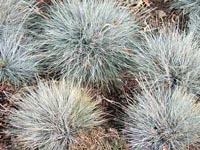Resource Library
Plant of the Week: Fescue, Blue
The University of Arkansas System Division of Agriculture does not promote, support or recommend plants featured in "Plant of the Week." Please consult your local Extension office for plants suitable for your region.
Plant of the Week
Blue Fescue
Latin: estuca ovina var. glauca

Grasses have become a staple of the modern landscape. But, like many garden styles, the use of grasses was recycled from an earlier time, the end of the Victorian era.
Ladies of fashion used the billowy grass plumes and ostrich feathers to adorn everything from their mantle to the fussy hats for which they are so famous. Another grass, the diminutive blue fescue, was also popular during that era to edge the elaborate bedding plant displays the Victorians so loved.
Blue fescue (Festuca ovina var. glauca) is a cool season, clump-forming perennial grass that grows about 10 inches tall and wide. The fine-textured leaves are thin and wiry and blue-gray in color. The blue coloration is caused by the deposit of a heavy coat of surface wax that protects the leaves from desiccation.
In mid-spring, it sends up a floppy inflorescence that mainly distracts from the symmetrical display of the pincushion like foliage. Ambitious gardeners usually trim off the flower stems as soon as they appear. The grass is native throughout the mountain ranges of central Europe.
Grasses lump conveniently into warm season and cool season types. Blue fescue is a cool season grass. The cool season grasses grow best during the cool part of the year while the warm season species grow best during the hotter months. Part of the cause for this basic difference in physiology is the nature of the oils (lipids) used in the cell membranes.
Cool season plants have lipids that remain liquid at low temperatures while the lipids of warm season plants solidify when the weather cools. Once that happens, the cell membrane is shot, and the cell dies.
Much of the increased popularity of grasses in the modern landscape design is due to the tireless promotion of a nurseryman named Kurt Bluemel, from Baldwin, Md. Bluemel has given his unwavering support to grasses for over two decades and has been responsible for introducing many of the newer and choicer types to the nursery trade. Grasses fit nicely into the "new American landscape" style that features native plants in bold, wispy designs.
Blue fescue is primarily used as an edging plant or occasionally as a groundcover. It blends well with small perennials in the border or for defining the edges of annual beds.
Because it's a cool season grass native to the mountains of Europe, it suffers during the heat and humidity of an Arkansas summer. But, if planted in a sunny, well drained, and not overly rich site, it tends to persist for a number of years. The life expectancy can be extended almost indefinitely if the grass is frequently divided.
Division can be done in the fall or very early spring. It should be divided at least every other year, and annually is better. Split the clump into sections, discarding the center of the clump and replanting the more vigorous blue portion around the edge. Replant it at the same level it was growing.
By: Gerald Klingaman, retired
Extension Horticulturist - Ornamentals
Extension News - November 14, 2003
The University of Arkansas System Division of Agriculture does not maintain lists of retail outlets where these plants can be purchased. Please check your local nursery or other retail outlets to ask about the availability of these plants for your growing area.